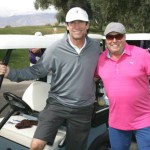
“RED” was a breakout-hit in London’s 2009 season before moving to New York, with the original cast of Alfred Molina and Eddie Redmayne, winning the 2010 Tony for Best Play, for playwright John Logan, as well as Tony’s for Best Lead Actor Molina, and Best Featured Actor Redmayne.

The rationale driving Logan’s story is the need to explore and understand the “creative process” which takes place in his riveting two-hander play “RED”, solidly directed by Michael Arabian. That’s a very tough assignment due to many gray areas within any creative moment. These moments, by their very nature, are difficult to define or isolate. Many storytellers have tried to convey and illuminate the linkage between the artist and society, but not many have succeeded. The struggle is a very personal experience and one that only the artist hears and feels.
The first lines uttered by John Vickery playing Mark Rothko, the late abstract/impressionist painter to Jason Maddy playing Ken, Rothko’s new assistant are “What do you see?” Ken hesitates …Rothko this time gruffly and demandingly barks again, “What do you see?” The question is a challenge thrown by the teacher to his new student, artist to artist.

What we the audience see onstage is an artist’s studio, with various canvases in various stages of completion, along with the tools of the painter’s trade: cans of paint, brushes, half completed frames, floor mops, saw horses, daubing rags all over the place, and
a general clutter that makes sense only to the two painters. For the next ninety minutes we have the opportunity to see not only Rothko’s innner demons, but his artistic philosophy as well. Ken’s patient acquiescence to Rothko’s outbursts, allow us to watch two actors deliver finely judged performances revealing their individual creative processes in the bargain, as well as the characters they portray. It’s something all actors do and personally experience every time they step onto a stage.
During the course of the play, Vickery says to Maddy, “There is only one thing I fear in life, my friend… one day the black will swallow the red.” Their is a lot of social as well as political philosophy of that sort that is discussed in Logan’s play. There are also many provocative issues raised concerning the role of the artist in society. At one point, Ken brashly questions Rothko’s theories of art, even challenging Rothko’s acceptance of a $35,000 dollar monetary commission to paint murals in the famous Four Seasons restaurant in New York City. Back in the 1950’s that was serious money for a few murals, even for a celebrated artist like Mark Rothko.

John Vickery and Jason Maddy bring experience and strength to their performances. Vickery especially does the heavy lifting, as the bellowing, tortured, introspective gifted painter Mark Rothko. Maddy, delivers a nice counter-point performance as Ken, the quiet and in awe assistant; together they complement the vision of director Michael Arabian’s intelligent production.
The technical credits are first-rate as well. Giulio Perrone’s artist/painter studio set design gives the actors the space they need to create their magic, and the subdued but, very effective, lighting design by Brian Gale enhances the mood and tone of this splendid ninety minute production.
“RED” continues at San Diego Repertory Theatre in Horton Plaza on the Lyceum Stage through April 27th.












